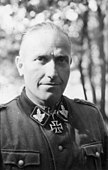Brigadeführer
In this article, we are going to thoroughly explore the topic of Brigadeführer and all aspects related to it. From its historical origin to its influence on current society, through its impact on different areas of study and its relevance in the contemporary world. We will also analyze different perspectives and opinions about Brigadeführer, with the aim of providing a broad and complete vision that allows the reader to thoroughly understand this topic and form their own opinion about it. Additionally, we will examine case studies and concrete examples that illustrate the importance of Brigadeführer in various contexts, as well as its evolution over time. Get ready to immerse yourself in an informative and enriching journey that will allow you to gain in-depth knowledge about Brigadeführer!
| Brigadeführer | |
|---|---|
 Post April 1942 gorget patch | |
Shoulder and camo insignia | |
| Country | |
| Service branch | |
| Abbreviation | Brif |
| Rank | One-star |
| NATO rank code | OF-6 |
| Non-NATO rank | O-7 |
| Formation | 1933 |
| Abolished | 1945 |
| Next higher rank | Gruppenführer |
| Next lower rank | Oberführer |
| Equivalent ranks | Generalmajor |
Brigadeführer (German: [bʁiˈɡaːdəfyːʁɐ], lit. 'brigade leader') was a paramilitary rank of the Nazi Party (NSDAP) that was used between 1932 and 1945.[1] It was mainly known for its use as an SS rank. As an SA rank,[2] it was used after briefly being known as Untergruppenführer in late 1929 and 1930.
History
The rank was first created due to an expansion of the SS and assigned to those officers in command of SS-Brigaden. In 1933, the SS-Brigaden were changed in name to SS-Abschnitte; however, the rank of Brigadeführer remained the same.
Originally, Brigadeführer was considered the second general officer rank of the SS and ranked between Oberführer and Gruppenführer.[3] This changed with the rise of the Waffen-SS and the Ordnungspolizei. In both of those organizations, Brigadeführer was the equivalent to a Generalmajor and ranked above an Oberst in the German Army or police. The rank of Generalmajor was the equivalent of brigadier general, a one-star general in the US Army.[4]The insignia for Brigadeführer was at first two oak leaves and a silver pip; however, the design was changed to three oak leaves in April 1942 after the creation of the rank SS-Oberst-Gruppenführer. Brigadeführer in the Waffen-SS or police also wore the shoulder insignia of a Generalmajor and were referred to as such after their SS rank (e.g. SS-Brigadeführer und Generalmajor der Waffen-SS und Polizei).[5]
-
Hermann Prieß as SS-Brigadeführer and Generalmajor of the Waffen-SS
Insignia
-
Gorget patches
1942–1945
(Allgemeine SS and Waffen-SS) -
Shoulder board
(Waffen-SS) -
NSFK gorget patch
-
NSKK gorget patch
| Junior Rank Oberführer |
SS rank and SA rank Brigadeführer |
Senior Rank Gruppenführer |
See also
Notes
- ^ McNab 2009, pp. 29, 30.
- ^ McNab 2009b, p. 15.
- ^ McNab 2009, p. 29.
- ^ Flaherty 2004, p. 148.
- ^ Stein 2002, pp. 297, 298 chart, 300 chart.
Bibliography
- Flaherty, T. H. (2004) . The Third Reich: The SS. Time-Life Books, Inc. ISBN 1-84447-073-3.
- McNab, Chris (2009). The SS: 1923–1945. Amber Books Ltd. ISBN 978-1-906626-49-5.
- McNab, Chris (2009b). The Third Reich. Amber Books Ltd. ISBN 978-1-906626-51-8.
- Stein, George (2002) . The Waffen-SS: Hitler's Elite Guard at War 1939–1945. Cerberus Publishing Ltd. ISBN 978-1841451008.





